What is the dream of drug makers? A medication that a wide swath of the population will take every day for the rest of their lives like statins, GERD drugs and, of course psych drugs for depression, ADHD and “bipolar disorder.”* So it is no surprise that drug makers have revived menopause as a “disease” for a generation of women who do not remember the first, lethal round of menopause mongering.
“Every middle-aged woman” will undergo the condition of “VMS”—“Vasomotor Symptoms, due to menopause”—trumpets a new round of menopause disease mongering online and on the radio. It’s a real disease but “no one is talking about it” blasts the campaign .** What?
But, from the 1940’s until 20 years ago, everyone was “talking” about the “disease” of menopause. In fact, in 2002, 61 million prescriptions were written for women in the U.S. for hormones to treat the so-called “disease” which was even once treated with electroshock therapy—yes ECT. Drug makers are banking, literally, on the fact that today’s “middle-aged women”—who were 25 when the first pathologizing occurred—don’t remember the first lethal dupe of menopause-as-a-disease.
Until the government-sponsored Women’s Health Initiative (WHI) found in 2002 that hormone replacement therapy (HRT) increased the risk of breast cancer by 26 percent, heart attacks by 29 percent, stroke by 41 percent, and doubled the risk of blood clots, HRT was a rite of passage for U.S. women like getting their first bra or using Tampax®. It also doubled the risk of dementia, increased the risks of losing their hearing, gallbladder disease, urinary incontinence, asthma, melanoma, ovarian, endometrial and lung cancers and non-Hodgkin’s lymphoma.
HRT even made detecting breast cancer more difficult. A 1995 article in the journal Radiology said, “an increase in mammographic density” was demonstrated in most subjects undergoing continuous combined HRT. The therapy was such a scourge, when millions of women quit the drugs en masse in 2003, the occurrence of breast cancer fell seven percent in the U.S. and 15 percent in estrogen-feed tumors.
And HRT harm continues to this day. A 2019 WHI follow-up found that “breast cancer risk from menopause hormones may last decades” and that 19 years after using HRT, women still had a 29 percent greater incidence of breast cancer.
The Heart Break Of VMS
Why the revival? The drug company Astellas just received a new drug application for fezolinetant, a drug to treat “VMS” and selling the disease to create “demand” for a drug is a time honored drug maker tradition. It is buttressed by online “quizzes” and “symptom checkers” to help patients self-diagnose the sold condition and go to the doctor requesting the new drug. “Unbranded” advertising, in which a disease rather than a drug is sold, is often mistaken for messages from the CDC by the public which helps the sell.
VMS, says the new marketing campaign, impacts “many aspects of your life including your sleep, ability to focus, and personal relationships,” and tortures you as “your internal infernos.” “VMS can start as early as age 40 and can last longer than 10 years for some women.” Ka-ching.
Why does the FDA allow the shameless selling of diseases to sell unnecessary drugs? The same reason the government allows the FDA commissioner to have countless financial links to drug makers—literally a fox guarding the hen house.
News Media Helps the Pathologizing
It is not only drug makers who are pathologizing healthy, normal women. In February, The New York Times published a sniveling personal essay about the heartbreak of “perimenopause”—a term believed to be invented by drug makers to grow sales like “osteopenia” was coined for pre-osteoporosis to sell bone drugs.
Doctors are failing to treat the condition wrote the New York Times’ menstrual diarist which “suggests that we have a high cultural tolerance for women’s suffering. It’s not regarded as important.” What? The breast cancer, heart attacks, stroke, blood clots and ovarian, endometrial and lung cancers caused by HRT were not “suffering”? Read your medical history, diarist.
Ten years ago the New York Times Sunday magazine published another sniveling, women-are-victims piece called “The Estrogen Dilemma.” The pro-HRT article quoted five HRT “experts” who recommended the lethal treatments, the story omitting the fact that all of the quoted “experts” had financial links to hormone drug makers. Just good journalism. Several letters to the Times requesting a clarification went unheeded and the disinformation stands to this day.
Convincing healthy people they are sick makes more money for drug makers than developing and/or selling drugs for people who actually are really sick. It is appalling. Convincing healthy women that menopause is a disease that requires a drug is simply the latest example of Pharma’s business model.
*That is why effective antibiotics are neglected. They are only taken for a few days except, of course, in livestock who constitute the biggest market.
**Drug makers have discovered that giving a disease snappy initials like EPI and RA helps sell.
